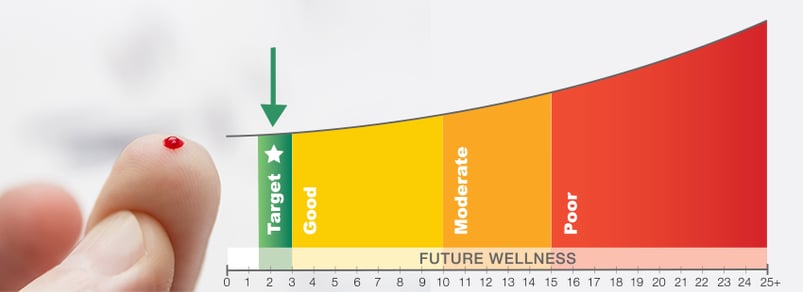The Zone can best be understood as the physiological state in your body where you slow down aging. If you want to know whether you’re in the Zone, these blood markers are the best way to tell. Here is a quick summary of what those blood markers are and what they indicate.
 The Cellular Inflammation Test: This test measures the level of two vital fatty acids in the blood, Arachidonic Acid (AA) and Eicosapentaenoic Acid (EPA). Arachidonic acid (AA) is produced from omega-6 fats in the body and can turn on the inflammatory response. Eicosapentaenoic acid (EPA) is an omega-3 fat that comes from fish and fish oils and helps turn off the inflammatory response. When these two fatty acids are balanced in your blood, as indicated by your AA/EPA ratio, your ability to control hormones (eicosanoids and resolvins) that modulate cellular inflammation is optimal. As the AA/EPA ratio in blood increases, cellular inflammation increases, and so does the likelihood of developing chronic disease in the future. This increased inflammation will make you age faster.
The Cellular Inflammation Test: This test measures the level of two vital fatty acids in the blood, Arachidonic Acid (AA) and Eicosapentaenoic Acid (EPA). Arachidonic acid (AA) is produced from omega-6 fats in the body and can turn on the inflammatory response. Eicosapentaenoic acid (EPA) is an omega-3 fat that comes from fish and fish oils and helps turn off the inflammatory response. When these two fatty acids are balanced in your blood, as indicated by your AA/EPA ratio, your ability to control hormones (eicosanoids and resolvins) that modulate cellular inflammation is optimal. As the AA/EPA ratio in blood increases, cellular inflammation increases, and so does the likelihood of developing chronic disease in the future. This increased inflammation will make you age faster. Best Way to Get in Range: The quickest way to lower your AA/EPA ratio is to supplement your diet with high purity omega-3 fatty acids. The more closely you follow the Zone Diet, the fewer omega-3 fatty acids you’ll need since the Zone Diet dramatically reduces the intake of omega-6 fatty acids and moderates insulin levels, both of which can increase AA levels in the body.
Best Way to Get in Range: The quickest way to lower your AA/EPA ratio is to supplement your diet with high purity omega-3 fatty acids. The more closely you follow the Zone Diet, the fewer omega-3 fatty acids you’ll need since the Zone Diet dramatically reduces the intake of omega-6 fatty acids and moderates insulin levels, both of which can increase AA levels in the body.
*This test is not routinely performed, but it can be done at home using our Cellular Inflammation Test Kit.
HbA1c: Hemoglobin A1c or glycosylated hemoglobin measures circulating glucose levels in the blood over the previous three months. HbA1c is used primarily as a marker of blood sugar control, but it can also be used as a marker of the activation of AMPK. AMPK is the master switch of metabolism that controls your ability to repair damaged tissue. Hyperglycemia, or high levels of circulating blood glucose, is a primary inhibitor of AMPK activity. Therefore, increasing your intake of polyphenols will have the most significant impact in reducing glycosylated hemoglobin levels. *This test may not be routinely performed. Check with your physician’s office and insurance provider before your next checkup to verify whether you’ll incur any additional fees if this is run.
*This test may not be routinely performed. Check with your physician’s office and insurance provider before your next checkup to verify whether you’ll incur any additional fees if this is run.
TG/HDL: The triglyceride (TG) to high-density lipoprotein cholesterol (HDL) ratio can be used as a marker of insulin resistance. The three organs most responsive to insulin are the adipose, liver, and muscle tissues. Insulin resistance is typically associated with an increase in body fat, but the first place you’ll be able to begin to measure its start is in the liver. The reason is that the liver is where dietary fats are repackaged into lipoproteins which transport triglycerides and cholesterol to cells. When insulin resistance develops, triglyceride levels rise, HDL levels decrease, and LDL (low-density lipoprotein) becomes smaller and denser and more likely to oxidize, leading to heart disease. Best Way to Get in Range: The best way to reduce insulin resistance is following the Zone diet. The Zone diet is a clinically proven anti-inflammatory diet. It is a calorie-restricted diet but without hunger or fatigue. The reason is that the Zone diet contains adequate protein, moderate amounts of carbohydrates, and is low in fat (primarily monounsaturated fat), which is the key to lowering insulin resistance.
Best Way to Get in Range: The best way to reduce insulin resistance is following the Zone diet. The Zone diet is a clinically proven anti-inflammatory diet. It is a calorie-restricted diet but without hunger or fatigue. The reason is that the Zone diet contains adequate protein, moderate amounts of carbohydrates, and is low in fat (primarily monounsaturated fat), which is the key to lowering insulin resistance.
*These markers (TG and HDL) are part of your complete blood count (CBC) routinely done in your physician’s office.
Summary
Being in the Zone is based on science. Your blood will tell you. Each of these three blood markers has to be their ideal ranges before you are in the Zone. In the Zone, you can help slow down your rate of aging. Getting all the necessary blood markers within their appropriate ranges will take about three months, although you can subjectively feel the benefits within a few days. The key to slowing down aging is staying in the Zone. Within 30 days of starting the Zone Diet and supplementing with the appropriate levels of omega-3 fatty acids and polyphenols, you will find these blood markers beginning to move you closer to the Zone and helping to improve your overall wellness by slowing down your rate of aging in every cell in your body.







Let Us Know What You Thought about this Post.
Put your Comment Below.